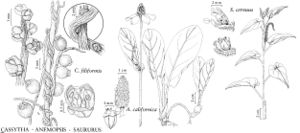Saururaceae
Herbs, perennial, rhizomatous, aromatic, glabrous to pubescent, in wet places. Stems simple or branched; vascular strands in 1 (-2) ring (s). Leaves basal and/or cauline, alternate, simple; stipules present, adnate to petioles; petioles usually present. Leaf-blade: margins entire. Inflorescences terminal, compact, conic spikes or lax, spikelike racemes terminal and/or opposite leaves. Flowers bisexual; perianth absent, each flower subtended by nonpeltate bract; stamens (3-) 6 (-8), hypogynous or epigynous; anther 2-locular; pistil 1, 3-5 (-7) -carpellate; ovary 1-5 or 3-5 (-7) -locular; placentation parietal or marginal; ovules 2 or 18-40; styles and stigmas distinct. Fruits capsules or schizocarps. Seeds 1 or many (-40); endosperm scanty; perisperm abundant; embryo minute.
Distribution
North America, Central America, Asia
Discussion
Genera 5, species 7 (2 genera, 2 species in the flora).
Selected References
None.
Illustrations
| Family ⠉ | Taxon | Illustrator ⠉ | |
|---|---|---|---|
 | Saururaceae Saururaceae Lauraceae | Anemopsis californica Saururus cernuus Cassytha filiformis | John Myers John Myers John Myers |
Key
| 1 | Inflorescences compact, conic, terminal spikes subtended by petaloid bracts; leaves mostly basal; fruits capsules, seeds 18–40. | Anemopsis |
| 1 | Inflorescences lax, spikelike racemes, opposite leaves and/or terminal, not subtended by petaloid bracts; leaves cauline; fruits schizocarps, mericarps (3–)4–5(–7), seed 1 per pericarp. | Saururus |